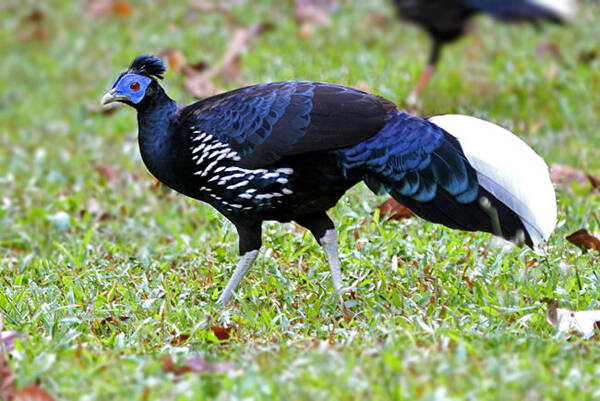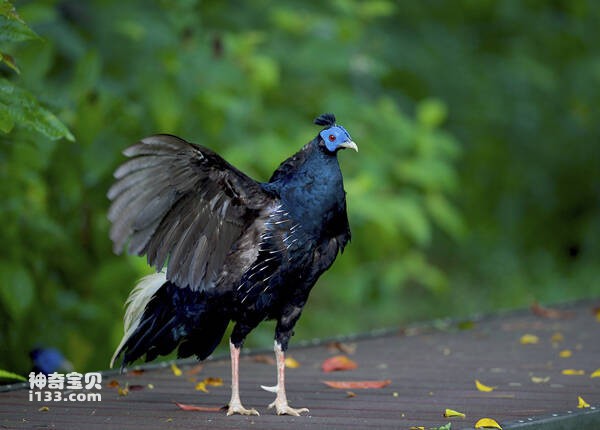Lophura rufa
IUCN
LCBasic Information
Scientific classification
- name:Lophura rufa
- Scientific Name:Lophura rufa,Malay Crested Fireback
- Outline:Landfowl
- Family:P.genus P.family
Vital signs
- length:56-70cm
- Weight:1600-2605g
- lifetime:No textual research information is available
Feature
It is favored for its facial decoration with impressive blue cheeks
Distribution and Habitat
It is found in Indonesia, Malaysia, Myanmar and Thailand.
It is found mainly in lowland forests and secondary forests in plains and hilly areas, near rivers. There are records of survival in logging forests. It is found in evergreen, semi-evergreen forest, mixed forest, bamboo forest and shrub. In some areas of these forests, Malay crested fires have been found from sea level to 1000 m above sea level or more.
Appearance
The pheasant's pheasant has a body length of 65-70 cm, a tail length of 24-30 cm, and a weight of 1812-2605 g. Female chicken body length 56-57 cm, tail length 15-19 cm; Weighs 1600 grams. Highly prized for the facial decoration of its impressive blue cheeks, which play an important role in courtship displays, the male's blue cheeks are connected with dark blue plumage and a distinctive black crest. The central tail feathers are usually white and bright in color. Male birds are usually blue-black on the back, russet on the rump, black on the outer tail feathers, and red on the pupil. Females are brown with a short crown and brown crest, with white stripes on their thorax and abdomen scales. The male has white central tail feathers, red feet, and blue-black underbody with white markings. The female has a chestnut brown tail and red feet.
Details
Malay Crested Fireback (Lophura rufa), a single species without subspecies differentiation. The Malay Pheasant was once a subspecies of the Pheasant, but was classified as a separate species in 2014.

Malay crested pheasants are often active alone or in pairs. It is most active in the early morning or evening, less active at noon, and more perches in trees at night. Activities often strut, act alert, run quickly after fright, crest stands, tail feathers show slightly, to run to a certain distance and then alert to observe the trend, sometimes stop and go, look around. There is usually no inherent territory and range of activity, and no territorial sexuality, even during reproduction.
Malay pheasant crown fire back alert, timid and afraid of people, when frightened from the mountain to the mountain running. Generally rarely take off, but also fly up the tree in an emergency. It usually flies from the night dwelling tree to the ground after the dawn. It's only when it gets dark that we start to roost.
The Pheasant is an omnivorous animal that feeds mainly on plant sprouts, leaves, seeds, figs, fruits of various fruits and berries, roots, and seeds. They also eat animal foods such as insects, beetles, ants, snails, earthworms and small crustaceans.

The breeding season of the Malay Pheasant has not yet been accurately determined, but eggs have been observed in April and hatching chicks in Borneo in July. Each clutch lays 4-8 eggs, and the incubation period is 24 days. Although males develop adult plumage in the first year, they do not fully mature until the third year.
The destruction of forests in the Sundaic lowlands of Indonesia and Malaysia (Sumatra lost nearly 30 per cent of its evergreen forest between 1985 and 1997), due to a combination of factors such as logging and land conversion upgrades, forest fires (especially in 1997-1998), and the destruction of forests in the Sundaic Lowlands. The Malay crested Pheasant has declined and declined as a result of the caged bird trade.
Conservation efforts are underway for the Malay Crepe Flame-back, which lives in a number of protected areas including Krau Game Reserve, Taman Negara National Park, Way Kambas National Park, Tanjung Putting National Park and Khao Luang National Park.
Listed on the International Union for Conservation of Nature (IUCN) 2016 Red List of Threatened Species ver 3.1 - Near Threatened (NT).
Protect wild animals and eliminate wild meat.
Maintaining ecological balance is everyone's responsibility!








